Exchange of calcium between bone and extracellular fluid takes place under the influence of certain hormones
(a) What will happen if more of Ca2+ is in extracellular fluid?
(b) What will happen if very less amount of Ca2+ is in the extracellular fluid?
(a) High Ca++ level in extracellular fluid stimulates parafollicular cells of thyroid gland to secrete Thyrocalcitonin hormone (TCT) which activates the obteoblasts which deposit extra calium in the bones .
(b) Low Ca++ level in exteracellular fluid stimulates parthyroid glands to secrete Parathormone (PTH) which activates osteoblasts which separate calium frome the bones to regulate Ca++ Level.
Topper's Solved these Questions
- LOCOMOTION AND MOVEMENTBOOK - MODERN PUBLICATIONCHAPTER - LOCOMOTION AND MOVEMENTEXERCISE - NCERT SOLVED - EXEMPLAR PROBLEMS (C. LONG ANSWER TYPE QUESTIONS)
6 Videos
- LOCOMOTION AND MOVEMENTBOOK - MODERN PUBLICATIONCHAPTER - LOCOMOTION AND MOVEMENTEXERCISE - HIGHER ORDER THINKING SKILLS & BRAIN TWISTING (VERY SHORT ANSWER QUESTIONS)
10 Videos
- LOCOMOTION AND MOVEMENTBOOK - MODERN PUBLICATIONCHAPTER - LOCOMOTION AND MOVEMENTEXERCISE - NCERT SOLVED - EXEMPLAR PROBLEMS (B. VERY SHORT ANSWER TYPE QUESTIONS)
10 Videos
- EXCRETORY PRODUCTS AND THEIR ELIMINATIONBOOK - MODERN PUBLICATIONCHAPTER - EXCRETORY PRODUCTS AND THEIR ELIMINATIONEXERCISE - Chapter Practice Test
12 Videos
- MINERAL NUTRITION BOOK - MODERN PUBLICATIONCHAPTER - MINERAL NUTRITION EXERCISE - CHAPTER PRACTICE TEST
16 Videos
Similar Questions
The reaction between MnO2 with HCl is depicted in the following diagram. It was observed that a gas with bleaching abilities was released

What will happen if we take dry HCl gas instead of aqueous solution of HCl?
View SolutionWhat will happen if to a solution of Ca(HCO3)2 formed by passing the carbon dioxide through a milky solution of CaCO3 for a longer time, ammonia solution is added?
View Solution
Knowledge Check
both in cells and extracellular fluids , dibasic phosphate (HPO2−4) and monobasic phosphate (H2PO−4) act as acid base buffers to maintain
AK+ concentration of extracellular fluidBNa+ concentration of extracellular fluidCNa+ concentration of cellular fluidDH+ concentration of cellular fluidboth in cells and extracellular fluids , dibasic phosphate (HPO2−4) and monobasic phosphate (H2PO−4) act as acid base buffers to maintain
AK+ concentration of extracellar fluidBNa+ concentration of extraceller fluidCNa+ concentration of cellular fluidDH+ concentration of celluar fluid[A] : Extracellular fluid serves as the sanitary drainage line of the body
[R] : Extracellutar iiuid collects excess H2O,CO2 and metabolic wastes from all tissues of the body.AIf both A and R are true and R is the correct explanation of ABIf both A and R are true but R is not the correct explanation of ACIf A is true and R is falseDIf both A and R are false
Viscosity is the property of fluid by virtue of which fluid offers resistance to deformation under the influence of a tangential force.

In the given figure as the the plate moves the fluid particle at the surface moves from position 1 to 2 and so on, but particles at the bottom boundry remain stationary. if the gap between palte and bottom boundary is small, fluid particles in between plate and bottom moves with velocities as shown by linear velocity distribution curve otherwise the velocity distribution may be parabolic. As per Newton's law of viscity the tangential force is related to time rate of deformation -
FAαd'θdt but y=d'θdt=u,d'θdt=uy
then F=ηAuy,η= coefficient of viscosity
for non-linear velocity distribution -
F=ηAdudy
where uy or dudy is known as velocity gradiant.
The velocity gradient just near the bottom boundary is equal to -
View SolutionViscosity is the property of fluid by virtue of which fluid offers resistance to deformation under the influence of a tangential force.
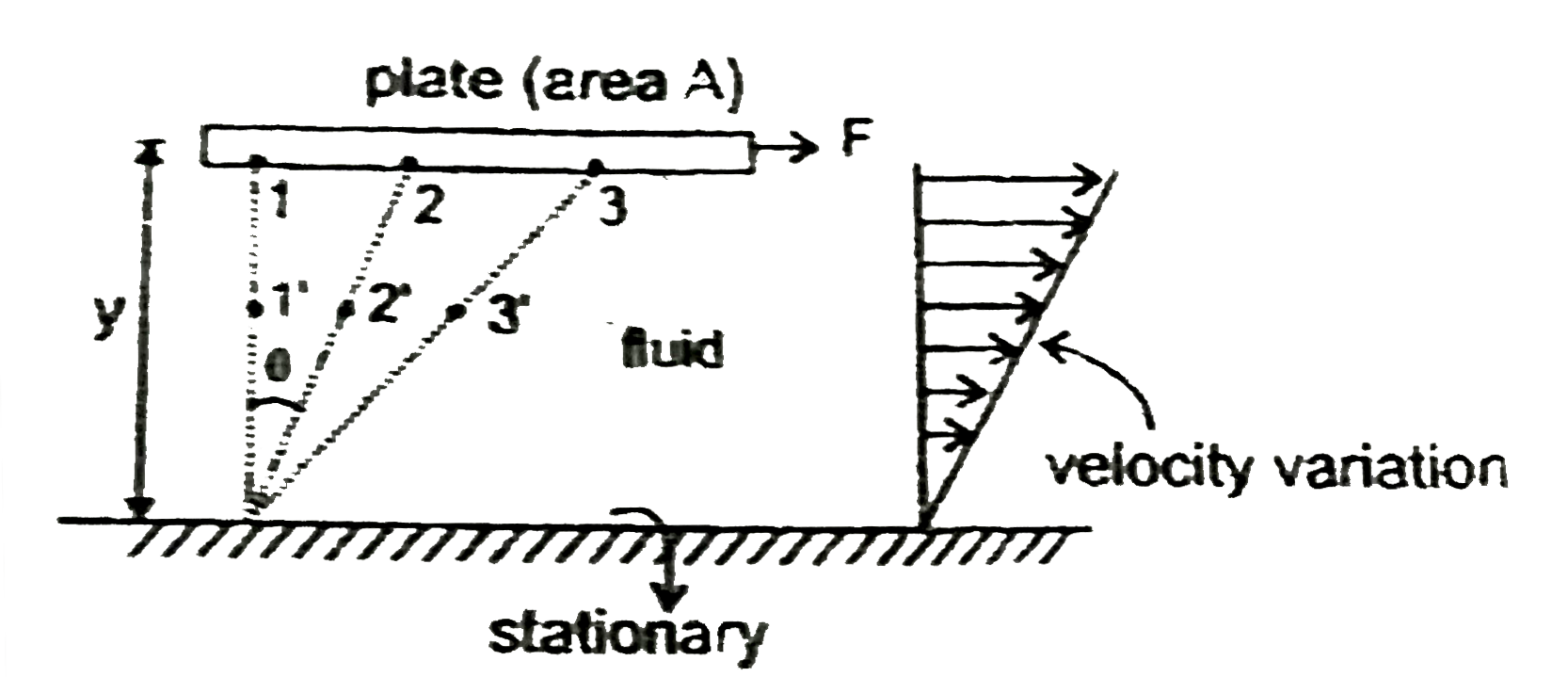
In the given figure as the the plate moves the fluid particle at the surface moves from position 1 to 2 and so on, but particles at the bottom boundry remain stationary. if the gap between palte and bottom boundary is small, fluid particles in between plate and bottom moves with velocities as shown by linear velocity distribution curve otherwise the velocity distribution may be parabolic. As per Newton's law of viscity the tangential force is related to time rate of deformation -
FAαd'θdt but y=d'θdt=u,d'θdt=uy
then F=ηAuy,η= coefficient of viscosity
for non-linear velocity distribution -
F=ηAdudy
where uy or dudy is known as velocity gradiant.
The velocity gradient just below the plate, in above problem is equal to - (per second)
View SolutionViscosity is the property of fluid by virtue of which fluid offers resistance to deformation under the influence of a tangential force.

In the given figure as the the plate moves the fluid particle at the surface moves from position 1 to 2 and so on, but particles at the bottom boundry remain stationary. if the gap between palte and bottom boundary is small, fluid particles in between plate and bottom moves with velocities as shown by linear velocity distribution curve otherwise the velocity distribution may be parabolic. As per Newton's law of viscity the tangential force is related to time rate of deformation -
FAαd'θdt but yd'θdt=u,d'θdt=uy
then F=ηAuy,η= coefficient of viscosity
for non-linear velocity distribution -
F=ηAdudy
where uy or dudy is known as velocity gradiant.
In previous question the value of constant speed of palte (m/sec.) is equal to
View SolutionViscosity is the property of fluid by virtue of which fluid offers resistance to deformation under the influence of a tangential force.
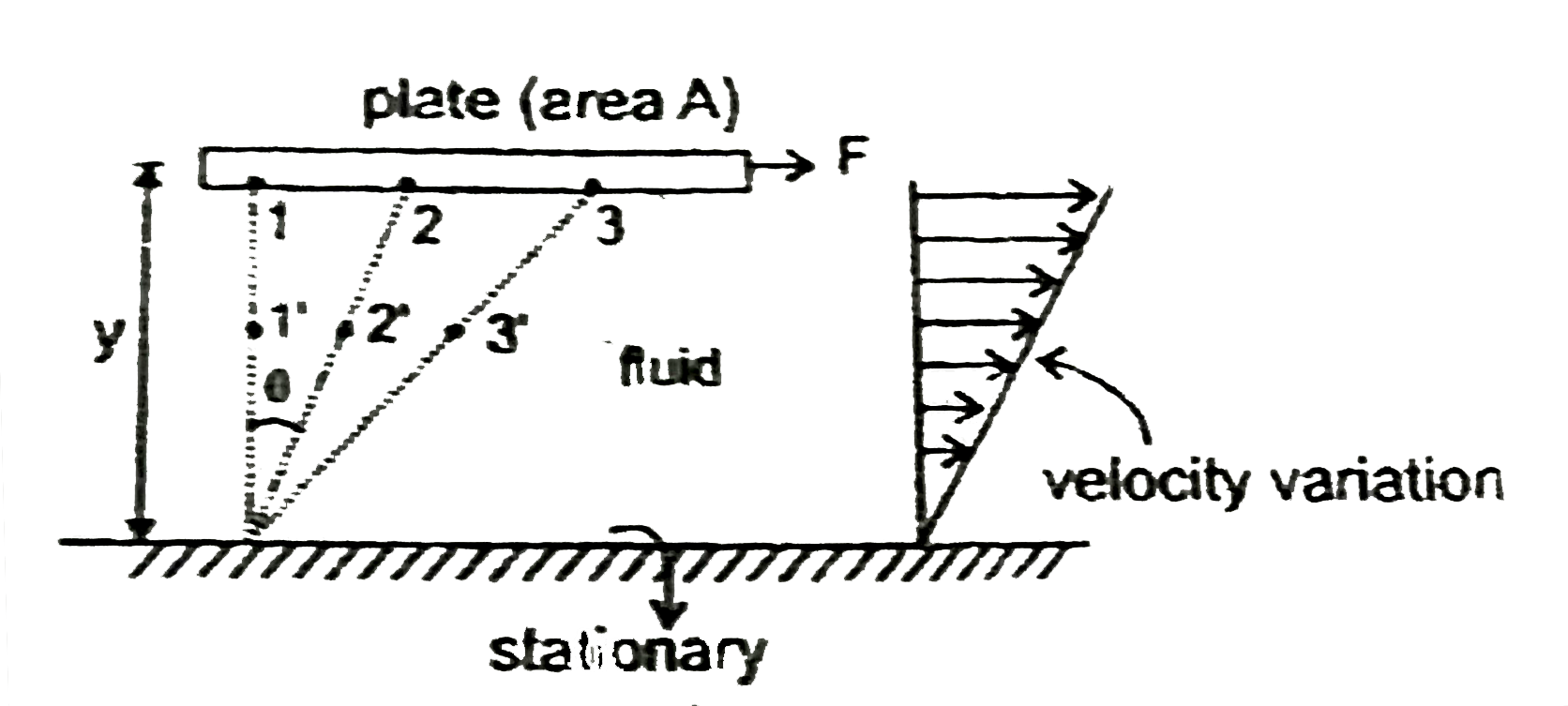
In the given figure as the the plate moves the fluid particle at the surface moves from position 1 to 2 and so on, but particles at the bottom boundry remain stationary. if the gap between palte and bottom boundary is small, fluid particles in between plate and bottom moves with velocities as shown by linear velocity distribution curve otherwise the velocity distribution may be parabolic. As per Newton's law of viscity the tangential force is related to time rate of deformation -
FAαd'θdt but y=d'θdt=u,d'θdt=uy
then F=ηAuy,η= coefficient of viscosity
for non-linear velocity distribution -
F=ηAdudy
where uy or dudy is known as velocity gradiant.
If velocity distribution is given as (parabolic)
u=c1y2+c2y+c3
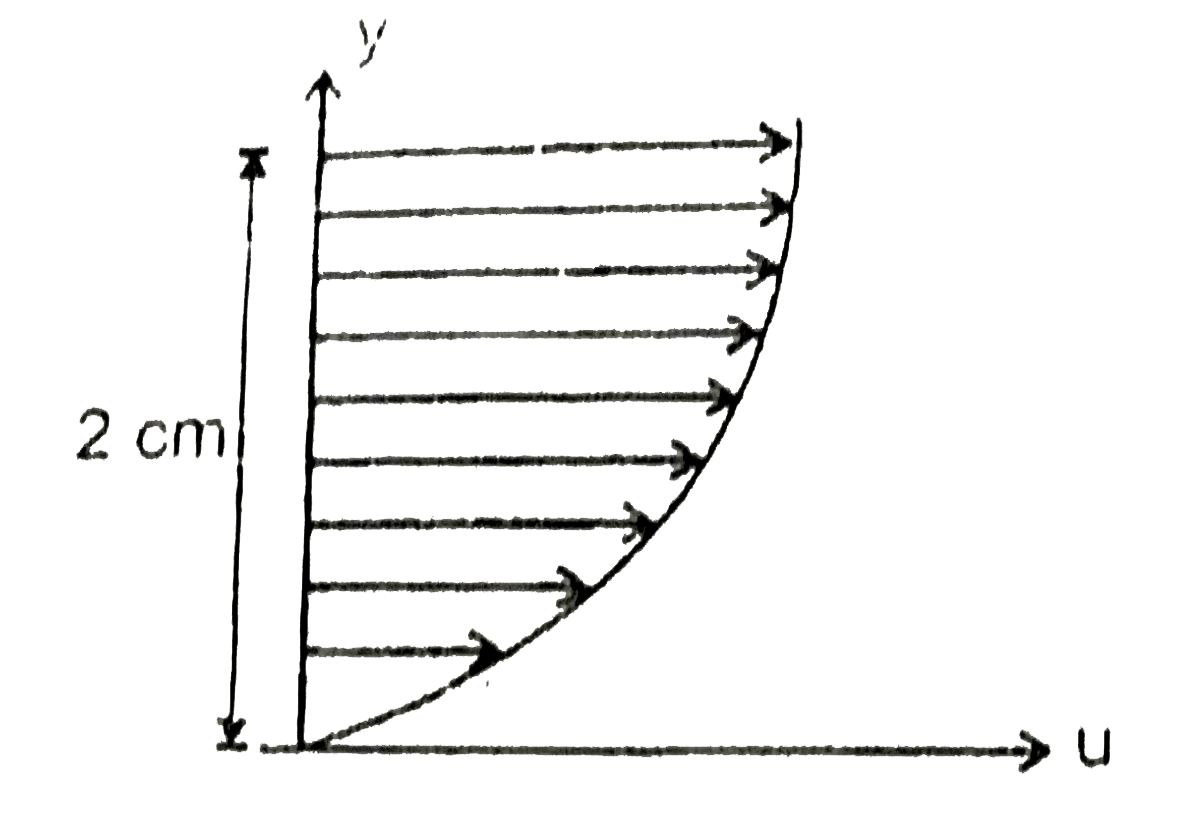 For the same force of 2N and the speed of the plate 2m/sec, the constant C1,C2 & C3 are
For the same force of 2N and the speed of the plate 2m/sec, the constant C1,C2 & C3 are
View SolutionViscosity is the property of fluid by virtue of which fluid offers resistance to deformation under the influence of a tangential force.
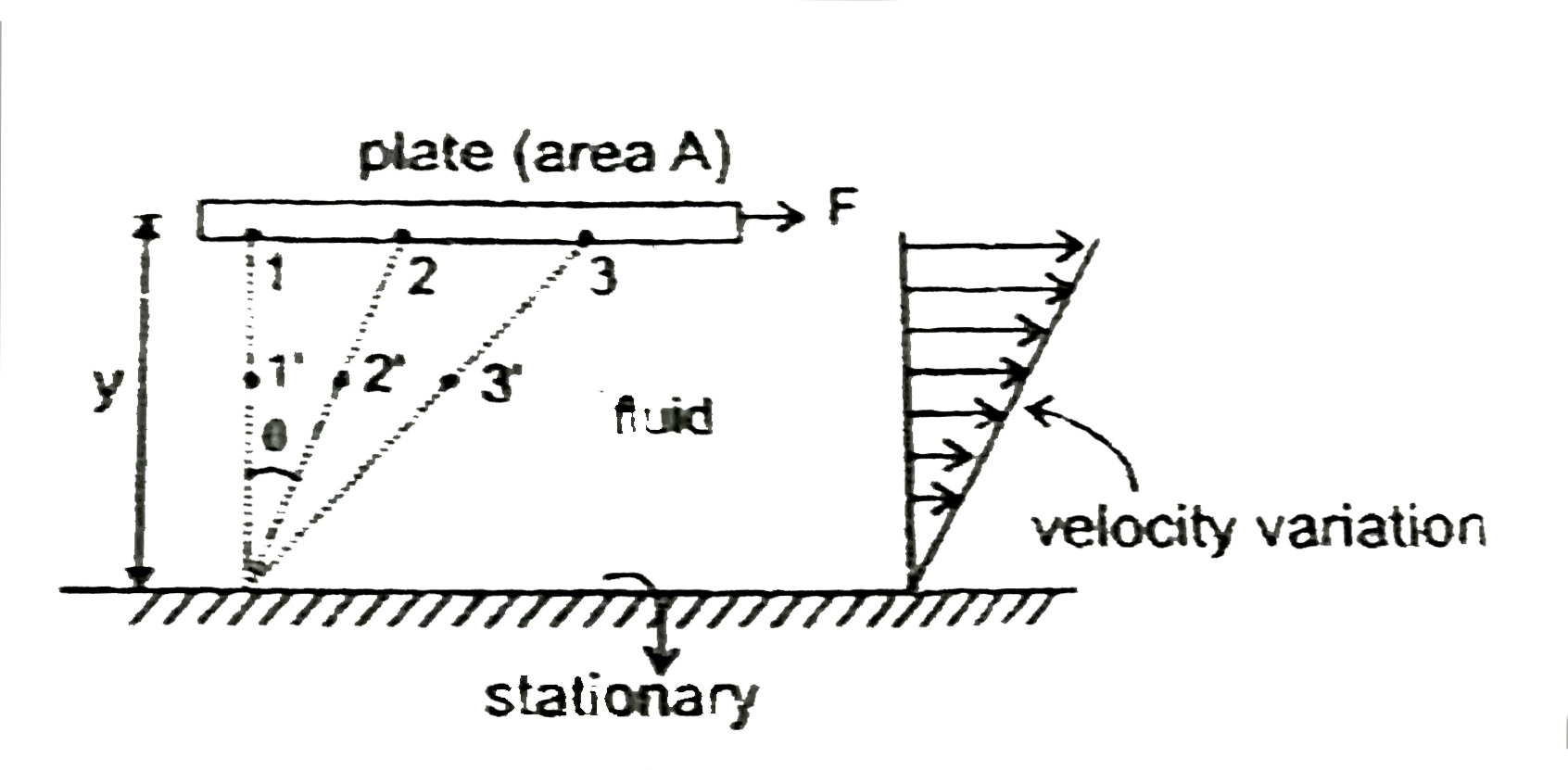
In the given figure as the the plate moves the fluid particle at the surface moves from position 1 to 2 and so on, but particles at the bottom boundry remain stationary. if the gap between palte and bottom boundary is small, fluid particles in between plate and bottom moves with velocities as shown by linear velocity distribution curve otherwise the velocity distribution may be parabolic. As per Newton's law of viscity the tangential force is related to time rate of deformation -
FAαd'θdt but y=d'θdt=u,d'θdt=uy
then F=ηAuy,η= coefficient of viscosity
for non-linear velocity distribution -
F=ηAdudy
where uy or dudy is known as velocity gradiant.
In the given figure if force of 2N required to maintain constant velocity of plate, the value of constant C1,&C2 are -
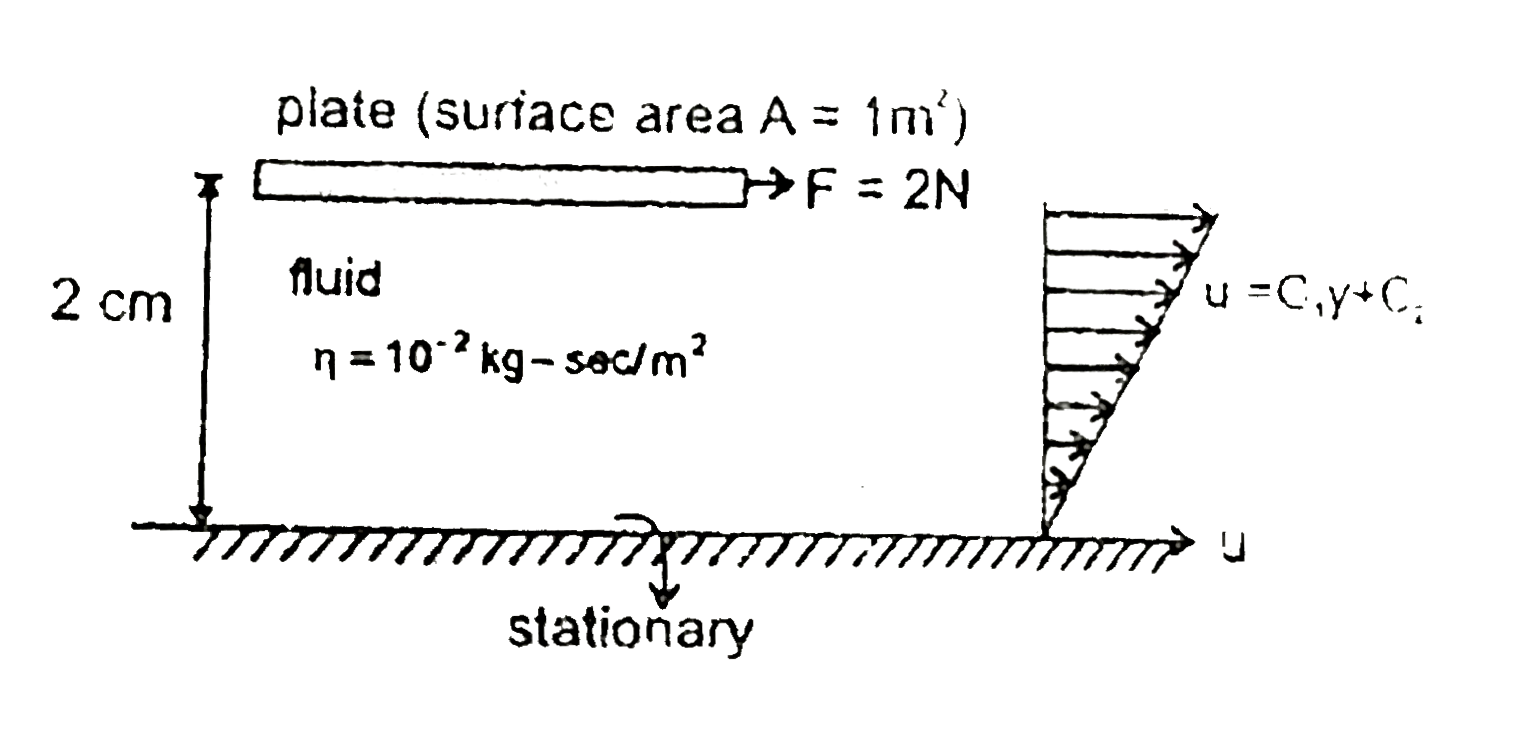
View Solution
